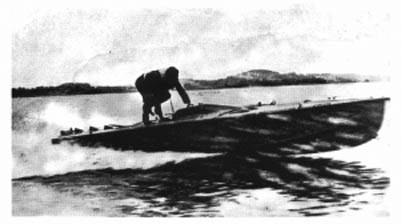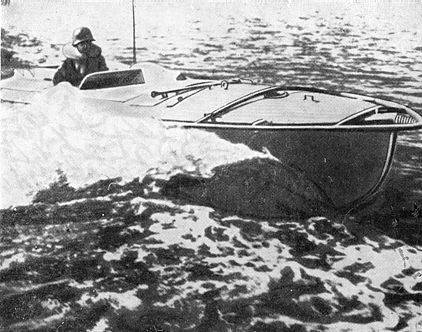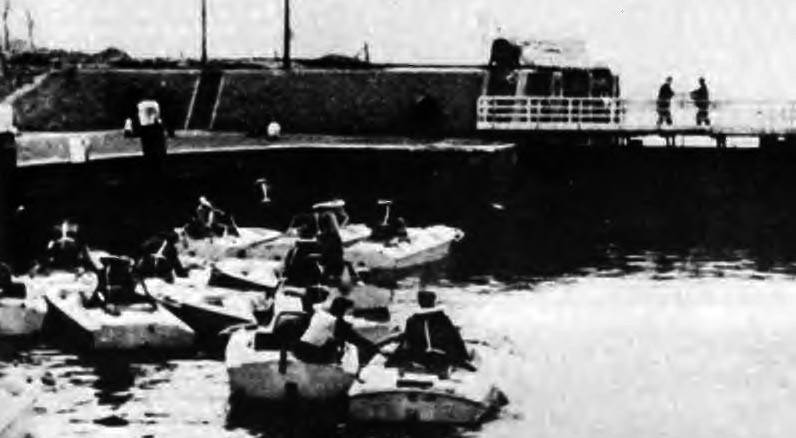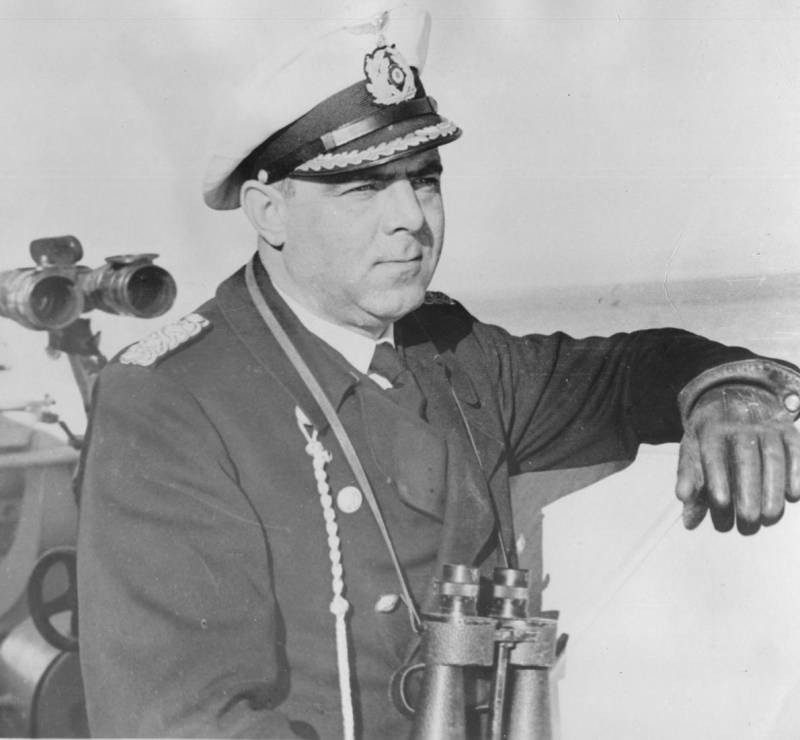Kriegsmarine combat swimmers: remote controlled boats
- from the personal notes of Vice Admiral Helmut Geye, commander of the "K" formation.
After the catastrophic losses incurred during the attacks on the allied invasion fleet, Formation K began to develop new weapons and tactics for their use.
However, the activities of the Kriegsmarine bore a general imprint of decline, which began to slowly but surely overwhelm all of Germany.
The Germans came to the use of remotely controlled boats, rather by chance, than from a purposeful calculation. After the start of the landing in Normandy, the commander of the "K" formation, Vice-Admiral Gaye, had to solve an extremely serious question - what means he, in general, could use to counter the fleet allies?
What flotilla could be the first to go to the Bay of the Seine to fight the enemy?
The possibilities of large-scale production of "Neger" were exhausted, and the remaining pilots were decidedly insufficient for a new combat operation. The batch of new single-seat submarines of the Bieber type, in turn, were exclusively training units.
And then the boats "Linze" appeared on the scene.
As paradoxical as it may sound, Geye knew practically nothing about this weapon, although its design began much earlier than other assault weapons.

The problem of the situation was that the idea of creating "Linze" did not arise at all at the headquarters of the naval department. It belonged to the infamous Brandenburg unit, which had 30 ready-to-use devices at its disposal.
Elite saboteurs, however, were in no hurry to place them at the disposal of the Kriegsmarine - for this Geye had to use his connections in the highest military circles of Germany. Only after the Supreme High Command of the Wehrmacht issued a corresponding order, the Brandenburg regiment agreed to hand over its remotely controlled boats.
But, as often happens in a cramped resource base, as well as due to the lack of sufficient time for preparation, everything did not go according to plan.
On June 10, 1944, the already known Boehme caperang arrived in Le Havre. There, in a great hurry, he began to prepare all the necessary organizational measures for the deployment of naval saboteurs. Ten days later, the first flotilla of boats "Linze" (10 - remote control and 20 - exploding) under the command of Lieutenant-Commander Kolbe arrived at the scene.
Initially, the combat swimmers were stationed on the territory of the shipyard in one of the Seine branches - there they were more or less sheltered from air attacks. However, on June 29, they moved to a naval port - in the evening they were to carry out the first operation.
Problems overtook naval saboteurs already at this stage. When the boats were designed at Brandenburg, no one had any idea what distances they would have to cover for a war at sea - the vehicles were equipped with fuel tanks in the regiment, based on a cruising range of only 32 km. For serious sorties, this was not enough - and the "K" compound had to mount additional tanks in the most haste manner.
Naturally, this was not enough - the distance from Le Havre to the Allied landing zones was approximately 40 kilometers. The only sensible solution was the idea of towing the Linze to the area of their combat deployment. For this purpose, it was decided to use minesweepers, which were deployed along with the saboteurs.
In the port, just before the start of the operation, the combat swimmers were overtaken by an accident. The Linze pilots checked the wires of the electric fuses. In the course of the trial, an explosion suddenly sounded, which shook the entire area of the parking lot and the ships located there.
As it turned out, one of the servicemen of the "K" compound, who was on his boat at the side of the minesweeper, forgot to disconnect the explosive charge from the electric fuse before testing the latter ...
Then "Linze" for the first time demonstrated their combat effectiveness on their own creators. The saboteur's mistake cost the Germans the boat and the minesweeper.
Some time after the incident, the boats gave up and went on their first combat mission.
The minesweepers took 3-5 Linza in tow. In this way, the saboteurs planned to get to the mouth of the Orne, and from there to start independent actions.
And here the second big difficulty awaited them.
Very big.
As soon as Le Havre was left behind, the minesweepers increased their speed significantly. It was then that the pilots had to face the unforeseen difficulties of sailing in tow.
Three-point excitement was enough for the "Linze" to face the threat of sinking. Boats one after another became victims of waves: here the towing cable broke, someone went out of order, because of the roll, water accumulated (and some "Linze" scooped it up so much that the electric cables got wet and short circuits occurred).

When the minesweepers nevertheless reached the mouth of the Orne, of the eight links (the link included a control boat and two exploding boats) that left Le Havre, only two were fully combat-ready.
It is worth paying tribute to the decisiveness of the Germans - even with such a modest composition, they risked going in search of enemy ships.
However, the weather was foggy that night - it did not allow them to achieve at least some success. The Germans were shackled in maneuver, they had to fight the onslaught of the sea non-stop. Depressed and disappointed, with the first rays of the sun, the saboteurs turned back to the shore.
The experience of that night was a bitter and instructive lesson for them. Not having had enough experience to test and check the "Linze", the combat swimmers fell into the trap of their own haste and delusions.
Our operational inspector, Captain 1st Rank Boehme, stood on the shore with a bottle of vodka and poured a full tea glass for each arriving person. Sergeant Major Lindner reported to him on the successful completion of the assignment.
I lit a cigarette, my hands were trembling. Everyone around was laughing, questioning and telling stories. But we already felt a little uncomfortable. At sea, no one noticed fatigue, but the operation and the return from it demanded the utmost tension from our muscles and nerves.
Now everything was over, the tension was replaced by lethargy for several minutes, we were simply exhausted. There remained only excitement, which, despite our mortal fatigue, prevented us from falling asleep, and we could not cope with it for a long time. "
- from the memoirs of Corporal Leopold Arbinger, naval saboteur of the "K" formation.
Linze gets a new life
After an unsuccessful debut, compound "K" decided to independently rework and produce new "Linse".
Naturally, the new model was based on old developments, but the unsuccessful experience of the first operation made it possible to significantly improve the seaworthiness of the boats.
The full-scale revision of "Linze" took four weeks. All this time, naval saboteurs were actively training in the Blaukoppel camp (this base was located in a pine grove near the mouth of the Trave River - this location was not accidental, because the trees served as a camouflage in case of an air attack).
During training, they worked actively to develop new tactics and developed a very effective pattern of action.
The main combat unit of the compound was the "Linze" link - 1 control boat and 2 remotely controlled ones. In the search mode, they moved at a speed of 12-19 km / h - this made it possible to minimize the noise of the running engines as much as possible. Each exploding boat carried only one pilot, and the control boat carried a pilot and two gunners. The driver of the remote control boat was also the flight commander.
Anchorage was chosen as a typical target. Their search was carried out in a dense formation, which disintegrated only after the detection of the enemy.
The attack process itself was not a task for the faint of heart - the rapprochement with the allied ships took place at low speed. It was too dangerous to give full engine speed - the enemy could pay attention to the noise (it should be noted that the boats had mufflers) and had time to take countermeasures.
While the Linze was creeping towards the target at low speed, the control vessel moved directly behind them. After the signal of the flight commander, the attack began: the pilots squeezed all possible speed out of the boats, brought the electric fuse into a firing position and started the remote control device. As a measure of distraction during the movement, the pilots scattered domes from the cockpits of the "Neger" - this helped to temporarily focus enemy fire on false targets.
After that, the light wooden boat, loaded with explosives, set off on the last voyage, using the full power of its 95 horsepower Ford gasoline eight-cylinder engine. The pilot was in the cockpit for a while to make sure the boat was on the correct course. Several hundred meters before the target, he jumped into the water - now his main task was survival.
Then everything depended on the gunner on the control boat - he had to direct the "Linze" to the target, controlling their rudders with the help of a transmitter.
It was for this that two crew members were required - each of them controlled one "Linze".
It is worth mentioning separately about the VHF transmitter itself.
It was a small black box - the size made it easy to put it on your knees. To avoid superposition of coherent waves, they worked at different frequencies. The remote control device itself on the "Lens" was the same device that was used on the famous self-propelled mine "Goliath".
The functionality of the device was as follows:
1) right turn;
2) left turn;
3) turning off the motor;
4) turning on the motor;
5) turning on trolling;
6) the inclusion of a full stroke;
7) detonation (only in case the boat does not hit the target).
Taking into account the fact that the boats needed to attack the enemy at night, the pilots, before the jump, activated special signal equipment, which was designed to facilitate the control process for the gunners.
It was a green lamp at the bow of the boat and one red at the stern. The red one was below the green level in terms of level, and both lamps could be seen only from the stern of the "Linze" - it was by them that the gunners were guided.
The mechanism was pretty straightforward: if the red dot was below the green one on the same vertical, it meant that the Lens course was correct. If the red dot turned out to be, for example, to the left of the green one, it means that he needed a correction using the transmitter.
That was the theory - in practice, the matter looked much more complicated.
The sailors of the Allied fleet did not eat their bread in vain - their numerous security forces thwarted the Linze attacks over and over again. As soon as they suspected the presence of boats, they activated the lighting equipment and unleashed a barrage of shells and large-caliber bullets at any suspicious area of the sea.
Under these conditions, the only weapon of the German saboteurs was speed and, perhaps, luck.
The control boat needed not only to direct the "Linza" to the target, actively maneuvering under fire (which in itself was not an easy task), but also to pick up the pilots who had jumped out of the water. Only after that the German saboteurs could retreat - which, of course, was not always possible.

Now let's talk about the direct process of the combat use of the "Linze".
A reinforced metal frame was mounted along the bow of the boat, which was held by 15 centimeter spiral springs. On impact, the springs were compressed and sent current through the contact fuse. That, in turn, caused a detonation of the thick tape, twice encircling the entire bow of the boat.
The tape detonated and blew apart the nose of the "Linze" - from this the heavier aft part with an engine and a 400-kilogram charge of explosives immediately sank to the bottom.
At the same time, a delayed action fuse was activated - usually it was set for 2, 5 or 7 seconds. This was not done by chance - this is how the main charge worked at a certain depth. It exploded next to the underwater part of the hull, striking a blow similar in strength to the detonation of a bottom mine.
After all the above manipulations, in case of successful (or not) destruction of targets, the control boat picked up two pilots from the water and went away at maximum speed. The saboteurs needed not only to have time to get away from the escort ships, but also to reach the coast before dawn, with which another danger came - aviation.
As an afterword, I would like to quote a direct participant in those events, Lieutenant-Commander Bastian:
It was impossible even to imagine that this or that remote control boat returned to the port and the flight commander reported that the drivers of the exploding boats were killed or not found due to darkness or enemy fire. The comrades who remained on the water, powerless before the elements, were searched until they were dragged aboard, even if it took whole hours, even if the enemy exerted strong pressure. That is why the return of the units was sometimes delayed, so that it was necessary to sail already in the daytime, when it is easiest to become a victim of enemy fighter-bombers.
The flotilla suffered losses precisely during the return of the boats from the mission, and not in the infernal night cauldron of the enemy defense, where the "Linze" acted with great courage and skill. "
Продолжение следует ...
- Anzhey V.
- waralbum.ru militera.lib.ru

Information